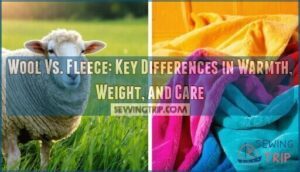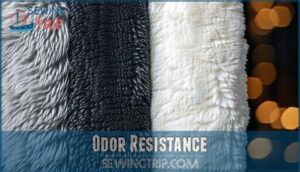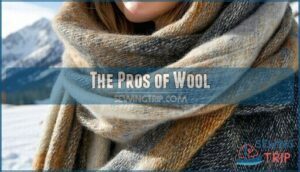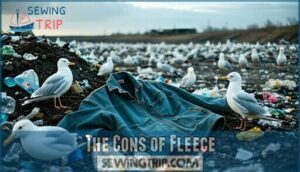This site is supported by our readers. We may earn a commission, at no cost to you, if you purchase through links.
 When you’re comparing wool vs fleece difference, you’re looking at nature versus technology.
When you’re comparing wool vs fleece difference, you’re looking at nature versus technology.
Wool comes from sheep and keeps you warm even when wet, plus it naturally fights odors like a built-in freshener.
Fleece is synthetic, lighter on your shoulders, and dries faster than your morning coffee cools down.
Wool costs more but lasts longer, while fleece won’t break the bank but might hold onto yesterday’s workout smell.
Think of wool as your reliable friend who’s always there through thick and thin, while fleece is your energetic buddy who’s ready for anything.
Each has its perfect moment.
Table Of Contents
Key Takeaways
- Wool keeps you warm even when wet, fights odors naturally, and lasts longer, but it can be pricey and needs special care.
- Fleece is lightweight, dries fast, and costs less, but it sheds microplastics, holds odors, and doesn’t last as long.
- Choose wool for extreme cold or wet conditions, and fleece for active, lightweight adventures.
- Wool is more eco-friendly and durable, while fleece offers budget-friendly, quick-drying convenience.
What is Wool?
Wool, nature’s gift from sheep and other animals, has been your wardrobe’s hard worker for centuries.
Its fibers trap air, creating a cozy blanket of insulation while letting moisture escape. Wool production includes shearing, cleaning, and spinning, making it a sustainable, renewable resource.
From luxurious cashmere to durable lambswool, wool fabric offers versatility like no other.
Wool clothing resists odors thanks to lanolin, its natural protector. Whether you’re bundling up in alpaca or Merino, you’re wrapped in wool’s warmth and history.
What is Fleece?
Fleece may feel soft and cozy, but it’s not all sunshine and rainbows.
Unlike natural fibers, fleece fabric comes from synthetic origins, specifically polyester made from petroleum.
Unlike wool’s natural origins, fleece starts its journey in oil refineries, transforming petroleum into cozy synthetic warmth.
The manufacturing process creates durable yet non-biodegradable materials, which don’t break down over time.
Washing fleece releases microplastics—tiny bits of polyester—that flow into waterways, impacting marine ecosystems.
Even recycled fleece, made from plastic bottles, doesn’t escape this problem.
While it’s a creative re-use, recycled fleece fabric still sheds microplastics when washed.
Here’s a breakdown of synthetic fleece properties and its impact:
- Derived from petroleum – Made from non-renewable fossil fuels.
- Microplastic release – Sheds particles during washing, polluting oceans.
- Non-biodegradable – Lingers in landfills indefinitely.
- Soft yet synthetic – Designed to mimic natural warmth.
- Recycling challenges – Repurposed fleece reduces waste, but not shed particles.
Fleece is known for its warmth because air pockets trap heat, making it ideal for colder conditions.
Key Differences Between Wool and Fleece
When you compare wool and fleece, it’s clear they each have unique strengths. Wool brings natural warmth and durability, while fleece is lightweight, quick-drying, and practical for everyday use.
Warmth
In terms of warmth, insulation factors make all the difference.
Wool excels in cold climates because it traps air and retains body heat, even when damp.
Its natural fibers are like tiny thermostats, keeping you cozy during inactivity or layering systems.
Fleece, on the other hand, prioritizes wicking moisture, so it’s better suited for mild conditions or activities requiring quick drying.
Comparing wool vs. fleece warmth, wool’s heat retention works wonders for steady body temperature, while fleece feels lighter for active wear, providing quick drying.
Water Resistance
In damp weather, you’ll appreciate how wool’s lanolin benefits keep you drier than fleece.
Wool resists water absorption, insulating even when wet, while fleece fabric clings and feels soggy.
Wool properties like natural moisture management make it a better choice.
Pair it with waterproofing layers for extra protection.
Unlike fleece, wool excels in wet insulation by trapping warm air.
- **Avoid clammy discomfort during rainstorms.
- **Stay warm with natural water resistance.
- **Fight elements with smart layering.
Weight
When you’re deciding between wool and fleece, weight plays a big role, especially if you’re active or traveling.
Wool, particularly merino wool, provides impressive insulation without adding much fabric density.
It’s like wearing a cozy blanket that forgot it’s supposed to be bulky.
The breathable fibers trap warmth efficiently, making wool ideal for layering benefits without weighing you down.
Fleece, on the other hand, often relies on thickness to keep you warm.
This can feel less packable when you’re short on space.
While fleece’s lightweight nature is convenient, its density can’t match wool’s ability to balance warmth and weight so effectively.
If your activity level involves hiking or layering up for cooler climates, wool’s packability factor and lightweight warmth make it a winner.
Fleece works too, but for long treks or variable conditions, wool does more with less, keeping your pack and body light.
Odor Resistance
In terms of stink resistance, wool wins hands down. Its antimicrobial properties fight odor-causing bacteria, giving wool self-cleaning powers that keep smells at bay.
Meanwhile, fleece odor retention is a real challenge as its fibers trap scents quickly. Fleece, however, offers superior wind resistance.
Here’s the scoop:
- Wool’s natural fibers minimize washing impact.
- Fleece absorbs odors rapidly.
- Wool vs fleece? Wool stays fresh longer and has natural fibers that provide additional benefits.
The Pros of Wool
You’ll discover that wool offers several impressive advantages that make it a top choice for cold-weather gear.
From its natural ability to resist odors to its remarkable talent for keeping you warm even when wet, wool brings unique benefits that synthetic materials can’t match, making it an excellent choice due to its ability to provide warmth.
Odor Resistant
After days on the trail, wool’s antimicrobial properties keep you smelling fresh while synthetic materials trap every hint of adventure.
Wool naturally resists bacterial growth that causes odors, unlike fleece’s tendency toward stink retention.
Here’s why wool wins the smell test:
- Natural antimicrobial compounds in wool fibers prevent bacteria from multiplying
- Superior sweat absorption wicks moisture away before odors develop
- Less frequent cleaning methods needed compared to fleece garments
Wool’s odor resistance means more hiking, less laundry.
Insulates When Wet
Picture yourself caught in a downpour during a mountain hike.
When the rain hits hard on the mountain trail, your fabric choice becomes the difference between comfort and misery.
While fleece becomes waterlogged and loses its warming power, wool keeps you cozy thanks to its unique structure.
Lanolin insulation creates a natural barrier that repels water droplets, preventing saturation.
Even when moisture penetrates, wool’s crimped fibers maintain air pockets that trap warmth.
This wet retention advantage comes from wool’s hydrophobic properties.
The fibers don’t absorb water like cotton or synthetic materials do.
Instead, they shed moisture while preserving insulation when wet.
In extreme conditions, this difference becomes life-saving.
Smart layering systems often feature merino wool base layers precisely for this reason.
For moisture management in unpredictable weather, wool outperforms fleece consistently, making it your reliable companion.
Breathable
Unlike fleece weave patterns, wool structure creates natural ventilation channels through its crimped fibers.
You’ll notice superior breathability during high activity levels since wool moves moisture outward efficiently.
This climate control advantage makes wool ideal for layering systems where thermal regulation matters.
While fleece traps heat close to skin, wool’s breathability prevents that clammy feeling during intense outdoor adventures.
Wool even absorbs up to 35% moisture before feeling wet, providing a significant climate control advantage and making it perfect for high activity levels.
Regulates Temperature
Beyond wool’s excellent breathability, its thermal regulation abilities make it shine in changing conditions.
Think of wool as your personal climate control system that automatically adjusts to keep you comfortable.
Wool’s unique fiber structure creates tiny air pockets that expand and contract based on your activity level and surroundings.
When you’re active, these fibers open up to release excess heat and moisture.
During rest periods, they close to trap warmth near your skin.
This natural thermal regulation beats synthetic alternatives hands down.
Here’s how wool’s temperature control works:
- Wool insulation adapts to your body heat, expanding when you’re warm and contracting when cold
- Wet insulation properties keep you warm even when damp from sweat or light moisture
- Fabric weight doesn’t compromise breathability – even thick wool sweaters allow air circulation
- Activity level changes trigger automatic ventilation adjustments through the fiber structure
Unlike fleece breathability which remains constant, wool’s thermal regulation responds dynamically to your needs, making it perfect for varying outdoor conditions and temperature swings.
The Cons of Wool
While wool offers excellent warmth and natural benefits, it’s not perfect for everyone’s needs or budget.
You’ll face higher costs, potential itchiness against sensitive skin, careful washing requirements, and longer drying times compared to synthetic alternatives.
Expensive
While wool offers impressive benefits, your wallet will feel the pinch.
Wool sourcing and production costs drive prices up substantially compared to fleece alternatives.
| Item | Fleece Jacket | Wool Sweater |
|---|---|---|
| Price | $40-60 | $100-200 |
| Material | Synthetic | Natural fiber |
You’ll pay 50-100% more for wool vs fleece cost.
Despite ethical concerns about synthetic materials, fleece remains budget-friendly.
However, wool’s long-term value often justifies the expensive initial investment through superior durability and performance.
Many consumers still seek high-end wool garments.
Can Be Itchy
Some people experience skin irritation when wearing wool fabric directly against their skin. Wool allergies and skin sensitivity can cause itchiness, especially with coarser fibers.
However, merino wool’s finer fibers reduce this problem substantially. If you’re prone to wool allergies, fleece alternatives offer similar warmth without the scratch.
Consider fiber softness when choosing materials for itch prevention. Individuals can find products for relief online.
High Maintenance
One unfortunate reality about wool care is its demanding nature compared to tossing fleece in the washer.
Wool’s delicate fibers require special attention to prevent damage and maintain their insulating properties.
Here’s what makes wool high-maintenance:
- Hand-washing only in cold water
- Special wool detergents required
- No machine washing or spin-drying allowed
- Careful reshaping while damp
- Flat drying to prevent stretching
To keep wool in top condition, you may need to purchase specialized cleaning solutions to ensure its longevity and insulating properties.
Slow Drying
Patience becomes your best friend when wool gets soaked.
While wool maintains warmth through fiber saturation, its drying time crawls compared to synthetic fibers.
You’ll wait hours for wool to shed moisture, unlike fleece’s quick-drying superpower.
Humidity impact makes this worse.
If your activity level involves frequent wetness, fleece wins the drying time comparison hands down, due to its superpower.
The Pros of Fleece
When you’re looking for gear that won’t weigh you down on your next hiking trip, fleece offers some serious advantages over traditional wool.
You’ll appreciate how fleece pulls moisture away from your skin, dries incredibly fast when wet, and feels almost weightless in your backpack compared to bulky wool alternatives.
Moisture Wicking
Synthetic fleece excels at moisture wicking, pulling perspiration away from your skin faster than wool ever could.
This superior moisture management keeps you comfortable during intense activities.
Here’s why fleece’s breathability factors make it perfect for active pursuits:
- Stops that clammy feeling when you’re working up a sweat
- Keeps your core temperature steady during winter workouts
- Prevents moisture buildup that makes other fabrics feel heavy
- Maintains insulation retention even with perspiration wicking
- Perfect activity suitability for high-energy adventures
Fleece’s breathability and wet performance create ideal conditions for maintaining comfort during demanding outdoor activities.
Quick Drying
When you’re caught in a downpour, fleece quickly bounces back.
Its synthetic fibers reject water, creating superior drying performance that keeps you comfortable.
Most fleece fabrics dry 3-5 times faster than wool, making them ideal for active pursuits.
| Drying Speed | Fleece | Wool |
|---|---|---|
| Light Moisture | 15-30 minutes | 1-2 hours |
| Moderate Wet | 45-60 minutes | 3-4 hours |
| Soaked Through | 1-2 hours | 6-8 hours |
| Environmental Factors | Wind/heat accelerates | Slower in humidity |
Lightweight
Fleece delivers impressive warmth without the bulk, making it your go-to choice for weight-conscious adventures.
A typical fleece jacket weighs about half what comparable wool garments do. Different fleece weight grades offer options from ultralight 100-weight to warmer 300-weight varieties, while wool’s natural density means more heft per layer.
This lightweight advantage becomes essential during long hikes or travel when every ounce counts. Blended lightweight fabrics and activity-specific weight considerations help you balance insulation needs with pack weight efficiently.
The Cons of Fleece
While fleece offers many practical benefits, it’s not without its drawbacks that you’ll want to take into account before making your choice.
From environmental concerns to performance limitations, these disadvantages can impact both your outdoor experience and your conscience.
Not Sustainable
When you choose fleece, you’re picking a fabric with serious biodegradability issues.
Made from petroleum-based synthetic fibers, fleece can’t break down naturally like wool does.
This synthetic production creates lasting environmental impact through resource consumption and microplastic pollution. Every fleece garment becomes a long-term waste problem, unlike wool’s natural decomposition process that doesn’t harm our planet.
The environmental impact of fleece is significant due to its non-biodegradable nature.
Not Eco-Friendly
While fleece keeps you warm, its environmental impact tells a different story.
Made from petroleum-based polyester, fleece production creates greenhouse gases and contributes to resource depletion through synthetic production processes.
- Microplastic pollution contaminates oceans when you wash fleece garments
- Chemical usage during manufacturing releases harmful plastics into ecosystems
- Biodegradability issues mean fleece won’t decompose for hundreds of years
- Environmental costs include microfibers that wildlife mistake for food
Durability Issues
Unfortunately, fleece doesn’t age gracefully like wool does.
You’ll notice fleece pilling and losing its fluffy texture after several washes, while wool longevity means your garments stay looking fresh for years.
Fleece’s poor abrasion resistance leads to thin spots and holes developing quickly.
Without decent repair options for synthetic fabrics, you’re stuck replacing fleece items far more often than durable wool pieces because of fleece’s lack of abrasion resistance.
Odor Absorption
Another durability concern you’ll encounter with fleece involves odor absorption. Your fleece jacket becomes a magnet for bacteria growth, trapping sweat and developing unpleasant smells quickly.
Unlike wool’s natural antimicrobial properties that resist odor retention, fleece synthetic fibers can’t fight bacteria effectively.
Performance clothing made from fleece requires frequent washing to combat this odor comparison issue. * Fleece traps body odors within 1-2 wears versus wool’s week-long freshness
- Synthetic fibers lack natural antimicrobial defenses that wool possesses inherently
- Cleaning methods become more frequent and intensive with fleece garments
Caring for Wool Garments
While fleece practically takes care of itself, wool fabric demands your attention like a high-maintenance friend who’s totally worth the effort.
Washing Wool starts with reading care labels carefully. Many modern wool garments are machine washable, but when in doubt, handwashing wins every time. Use cold water and a specialized wool detergent that won’t strip natural oils. If you’re brave enough for the machine, choose the delicate cycle and cross your fingers.
Drying Techniques matter more than you think. Skip the dryer completely – heat turns wool into doll clothes. Instead, gently squeeze out excess water, lay flat on clean towels, and reshape while damp. This prevents that dreaded shrinkage.
Storage Solutions keep moths away with cedar blocks or lavender sachets. Stain Removal works best when tackled immediately with cold water and gentle blotting. Stubborn stains might even require you to bleach yellowed wool, but always test a hidden area first. Repairing Damage like small holes can extend your wool’s life substantially, making proper care absolutely worthwhile.
Caring for Fleece Garments
Unlike wool’s delicate requirements, fleece clothing offers hassle-free maintenance.
Machine washable fleece fabric makes laundry day simple—just toss it in your washer with cold water and mild detergent.
For drying techniques, use low heat to prevent pilling and maintain the fabric’s loft.
Skip fabric softeners, which can reduce moisture-wicking properties.
For stain removal, treat spots immediately with gentle soap.
Storage methods are straightforward: fold or hang in a dry place.
This easy fleece care routine keeps your gear ready for adventures without fussy maintenance schedules.
Choosing Wool or Fleece for Your Needs
Your choice between wool and fleece isn’t just about warmth—it’s about matching material to mission.
Consider these factors when making your decision:
- Activity Level – High-intensity activities favor fleece’s quick-drying properties over wool’s slower moisture release
- Climate Conditions – Wet environments suit fleece; cold, dry conditions favor wool’s superior insulation
- Budget Considerations – Fleece costs less upfront, but wool lasts longer with proper care
- Intended Use – Wool excels for casual wear; fleece dominates active pursuits
- Personal Preference – Some find wool itchy; others prefer its natural feel
- Warmth Requirements – Wool vs fleece warmth depends on conditions and layering
- Environmental Impact – Wool’s renewable; fleece sheds microplastics
Frequently Asked Questions (FAQs)
Which is better, wool or fleece?
Like choosing between a trusty old friend and a modern companion, you’ll find wool excels in extreme cold and wet conditions.
While fleece wins for everyday activities with its lightweight, quick-drying convenience.
Are fleece blankets warmer than wool?
Wool blankets typically provide superior warmth compared to fleece due to their higher insulation value and ability to retain heat even when damp.
Making them your go-to choice for cold weather comfort.
What is the difference between fleece and wool coat?
You’ll find fleece coats are synthetic, lightweight, and dry quickly when wet.
Wool coats come from sheep, offer superior warmth even when damp, but they’re heavier and take longer to dry.
What are the disadvantages of fleece?
After washing your favorite fleece jacket five times, you’ll notice tiny plastic fibers floating in the water.
Fleece sheds microplastics, lacks natural water resistance, and can feel stuffy compared to breathable wool alternatives.
Can wool and fleece be blended together?
Yes, you can blend wool and fleece together. Many manufacturers create wool-synthetic blends that combine wool’s natural warmth with fleece’s durability and quick-drying properties, offering the best of both materials.
Which fabric pills more over time?
Fleece pills more than wool over time.
You’ll notice those annoying little fabric balls forming faster on fleece garments because synthetic fibers break down and tangle together more easily than wool’s natural structure, which is a complete concept that explains the difference in pilling between fleece and wool.
Do wool allergies affect fleece wearers?
If you’re sensitive to animal fibers, you’ll breathe easier knowing synthetic fleece won’t trigger wool allergies.
Since fleece contains no sheep proteins, you can wear it comfortably without worrying about reactions.
How do manufacturing costs compare between materials?
Production costs favor fleece substantially.
You’ll find wool’s expensive because sheep require year-round care, annual shearing, and complex processing.
Fleece uses cheaper petroleum-based materials and streamlined manufacturing, making it more budget-friendly for consumers.
Which performs better in extreme wind conditions?
When you’re battling fierce winds, wool’s your champion.
Its natural fibers create better windproof barriers than fleece’s synthetic weave.
Wool blocks gusts more effectively, keeping you warmer when nature releases its fury.
Conclusion
Did you know wool can absorb up to 30% of its weight in moisture without feeling wet?
Whether you’re drawn to wool’s natural warmth and odor resistance or fleece’s lightweight, quick-drying ease, choosing between them boils down to your needs.
Wool excels in durability and temperature regulation, while fleece offers affordability and low weight.
When comparing the wool vs fleece difference, think about your activity and environment. Both have unique strengths, so pick what fits best!
- https://www.denverfabrics.com/pages/wool/wool-fabric-care.aspx
- https://www.orvis.com/womens-sweatshirts
- https://goodonyou.eco/label-lingo-and-synthetic-fabrics-everything-you-need-to-know/
- http://webstersdictionary1828.com/Dictionary/fleece
- https://www.patagonia.com/stories/the-story-of-fleece/story-91208.html

















